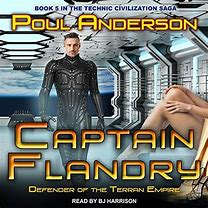Viewpoint character John Ridenour has interviewed Mayor Uriason. Now alternative viewpoint character Karlsarm interviews two prisoners, Uriason and his companion. We strongly suspect that that companion is Ridenour and our suspicion is almost immediately confirmed when Ridenour introduces both himself and Uriason to their captor. We now see Ridenour as seen by someone else, more specifically as seen one other person, namely Karlsarm. We are also told plenty about Uriason's responses although not from his pov. He looks comical to Karlsarm. He also looks insulted and probably is although this is not confirmed directly because the narrative does not go inside his head. Poul Anderson fully controls narrative point of view. Many readers accept povs without reflecting on them. They might have noticed if this scene had been written by Frank Herbert because, in that case, the pov would have switched indiscriminately back and forth between all three characters. I think that a failure to control pov reflects a failure to control the writing process.

5 comments:
Kaor, Paul!
It might be more a matter of taste, how many "interior" POVs we see in any one scene, section, or chapter a writer chooses to show us. But I do see your point, that, at least technically, it's better to show us just one POV at a time.
A bit oddly we never see anything from Nicholas van Rijn's POV, except once, in "Margin of Profit."
Ad astra! Sean
Sean,
More than taste. If an author jumps between povs during a single dialogue, then he is not describing anything that could have happened because each participant experienced the entire dialogue only from his own pov throughout.
Paul.
Kaor, Paul!
That does make sense.
Ad astra! Sean
Paul's right about that. Also, if you switch POV too often, people get confused.
Kaor, Mr. Stirling!
I agree.
Ad astra! Sean
Post a Comment